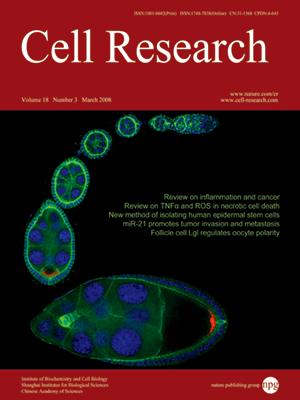
Volume 18, No 3, Mar 2008
ISSN: 1001-0602
EISSN: 1748-7838 2018
impact factor 17.848*
(Clarivate Analytics, 2019)
Volume 18 Issue 3, March 2008: 360-371
ORIGINAL ARTICLES
Enrichment of putative human epidermal stem cells based on cell size and collagen type IV adhesiveness
Juxue Li1,2, Chenglin Miao1,2, Weixiang Guo1,2, Liwei Jia1,2, Jiaxi Zhou1,2, Baohua Ma1, Sha Peng1,2, Shuang Liu1,2, Yujing Cao1 and Enkui Duan1
1State Key Laboratory of Reproductive Biology, Institute of Zoology, Chinese Academy of Sciences, Datun Road, Chaoyang District, Beijing 100101, China;
2Graduate School of the Chinese Academy of Sciences, 19 Yuquan Road, Beijing 100039, China
Correspondence: Enkui Duan(duane@ioz.ac.cn)
The enrichment and identification of human epidermal stem cells (EpSCs) are of paramount importance for both basic research and clinical application. Although several approaches for the enrichment of EpSCs have been established, enriching a pure population of viable EpSCs is still a challenging task. An improved approach is worth developing to enhance the purity and viability of EpSCs. Here we report that cell size combined with collagen type IV adhesiveness can be used in an improved approach to enrich pure and viable human EpSCs. We separated the rapidly adherent keratinocytes into three populations that range in size from 5–7 μm (population A), to 7–9 μm (population B), to ≥9 μm (population C) in diameter, and found that human putative EpSCs could be further enriched in population A with the smallest size. Among the three populations, population A displayed the highest density of β1-integrin receptor, contained the highest percentage of cells in G0/G1 phase, showed the highest nucleus to cytoplasm ratio, and possessed the highest colony formation efficiency (CFE). When injected into murine blastocysts, these cells participated in multi-tissue formation. More significantly, compared with a previous approach that sorted putative EpSCs according to β1-integrin antibody staining, the viability of the EpSCs enriched by the improved approach was significantly enhanced. Our results provide a putative strategy for the enrichment of human EpSCs, and encourage further study into the role of cell size in stem cell biology.
Cell Research (2008) 18:360-371. doi: 10.1038/cr.2007.103; published online 11 December 2007
FULL TEXT | PDF
Browse 1840


